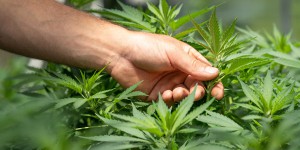By Ester Aso

PhD in Biology from the Universitat Pompeu Fabra, currently performing the tasks of Associate Professor of Pharmacology at the University of Barcelona. Her research work has focused over the last 15 years on the study of the role of the endocannabinoid system in mental illness and, especially, on the therapeutic potential of cannabinoids against neurodegenerative diseases such as Alzheimer's. As a result of this research, she has published 20 scientific articles related to cannabinoids and has participated in numerous research projects financed by public and private funds. Member of the Spanish Society of Research on Cannabinoids since 2004, she was a member of the Board of Directors from 2011 to 2 105.
The cannabis industry is experiencing unprecedented growth globally, driven mainly by legislative changes decriminalizing consumption and regulating the production of cannabis plant derivatives for therapeutic and, more restrictively, recreational purposes.
This progress at the political level responds essentially to the growing social demand for regulation of the use of medical cannabis. This demand, in turn, is supported in part by scientific advances that demonstrate the potential therapeutic uses of specific cannabis derivatives in an increasing number of diseases. Therefore, we can say that the boom in the current cannabis industry is largely due to the combination of scientific, social, political and economic interests.
Legalization of medical cannabis
Currently, more than 30 countries have legalized the therapeutic use of cannabis extracts and it is estimated that at least a dozen more will do so in the coming years. Uruguay, Israel and the Netherlands have been pioneers in this regard, but it has probably been legislative changes in two world economic powers such as the United States of America (USA) and Canada that have contributed most to the current boom in the cannabis industry.
In the US, although it has not been legalized at the federal level, more than half of the member states have passed laws regulating the use of medical cannabis. In 10 of these states, including some of the most populous, the use of cannabis is legal for any purpose. In addition, the approval in May 2018 of the federal law known as the "Right to Try" [1], allows patients with terminal illnesses to access experimental therapies that have completed Phase I clinical trials, even though they have not yet been approved by the Food and Drug Administration (FDA) regulatory agency. In this way, the door has been opened for patients in critical situations to be treated with cannabis derivatives throughout the territory. On the other hand, the approval for the first time of a drug based on a cannabis extract, Epidiolex® [2], for the treatment of refractory childhood epilepsy by the influential and powerful FDA in June 2,018 has set an international regulatory precedent for the future approval of cannabis drugs for this and other uses.
On October 17, 2,018, Canada made a pioneering gesture, as although medical cannabis had been legal since 2001, the law that legalizes and regulates cannabis use for any purpose came into force on that day [3], thus making it the first global economic power to decriminalize cannabis completely. It should be noted that this law is the result of intense government consulting with the many actors involved: legislators, security forces, health experts, scientists, industry professionals, patient associations and citizens in general, 30,000 of whom participated actively in the consultation carried out by the authorities [4]. The law was passed with a threefold objective: to reduce the criminality associated with the illegal cannabis market, to protect young people from the risks associated with misuse of cannabis, and to promote public health and patient safety by allowing adults access to legal and controlled cannabis. It is possible that this law and Canada's controlled cannabis sales system, which combines the participation of the state and private entities in the network of authorized clinics, will become the model for other countries legalizing cannabis use in the future.
Growth of the cannabis industry
Faced with this increasingly favourable global framework for the legal production and sale of cannabis derivatives, the cannabis industry is looking at a huge potential market, valued at billions of dollars. In fact, some estimates place the growth rate of the cannabis industry at 16% per year for the coming years, so that by 2025 this business is expected to generate sales comparable to the current turnover of a fashion giant such as Inditex. These expectations of growth in the sector, comparable to those generated around dotcom companies during the first decade of this century, have not gone unnoticed by large investors. Prestigious economic journals such as Forbes, or very influential agencies in the financial and business sector, such as Bloomberg, have already devoted numerous articles to the cannabis industry, to which they present as the great opportunity to make a significant return on investments. Great fortunes such as that of PayPal co-founder Peter Thiel and the owner of Corona beer, have made major investments in this incipient industry, catching the attention of other large investment funds held by important entities in the banking, construction and metal sectors, among others. Thus, the stock market price of some producers of medical cannabis has shown a rate of growth much higher than that of traditional sectors or new technologies over the past year. The traditional pharmaceutical industry has not ignored this boom in the cannabis sector. Major pharmaceutical companies have established strategic alliances mainly with Canadian companies, pioneers worldwide in this sector, to gain the market for the production and distribution of cannabis preparations for therapeutic purposes.
In addition, the industry is exploring many other applications of cannabis beyond therapeutic or recreational use, including the manufacture of textiles, building materials, cosmetic products, fertilisers and animal feed, as well as food products. In fact, there are already numerous products for human consumption on the American market that contain some of the non-psychoactive components of cannabis, mainly cannabidiol, such as creams, oils, flours and even sweets and soft drinks. Large companies in the food sector such as Walmart and Coca Cola have valued the possibility of developing new products linked to cannabis. The cannabis business has also attracted the interest of small and large farmers in the US who have seen cannabis cultivation as a real alternative to the declining demand for tobacco or the devaluation of the price of once profitable maize and soybean crops [5].
The scope of this authentic boom in the cannabis industry must be assessed from the perspective of time, which will confirm whether the economic expectations created around this emerging sector materialize or not, but what is undeniable is that it represents a turning point for all actors involved in the cannabis sector: industry, politicians, consumers and researchers.
Opportunities and challenges
This new scenario opens up a range of new opportunities for all of them. First, it implies a very significant increase in turnover and the possibility of international expansion for companies already established in the cannabis industry. It also favours the creation of new companies in the sector and the diversification of the business of existing ones operating in other fields. In this regard, the example of Canada is quite illustrative, where 70 per cent of the more than 130 companies with a license to cultivate medical cannabis have obtained it in the past two years. It is estimated that in the first year after full legalization in Canada, up to 125,000 new jobs will be created in the sector [6], more than twice the number of current vacancies in Silicon Valley, where the world's largest high-tech corporations are concentrated. Secondly, this growth around cannabis will also benefit the scientific community linked to cannabinoid research, which will see in the cannabis industry an opportunity for professional development hitherto very limited by the scarcity of companies in this sector with investment in research and development and, on the other hand, a potential source of additional investment for research projects carried out in academic circles. This investment will undoubtedly lead to a greater understanding of the effects of cannabis and the potential therapeutic benefits of its extracts. Finally, consumers of therapeutic cannabis, and even recreational cannabis where it is legal, will also benefit from the possibility of easier access to controlled and quality products produced under the strict rules established by law, as well as the advice of professionals qualified to do so. In addition, consumer access to legal and controlled products will reduce the existing black market and the criminality associated with this illegal business.
However, this new global scenario also poses a number of important challenges. The news about the sector in recent years has generated enormous expectations regarding the therapeutic potential of cannabis at a social level. In order to meet these expectations and the growing demand from society, politicians in countries where change has not yet been legislated will have to face legal reform that may generate controversy in certain sectors and foster a network of collaboration between industry, health professionals and citizens that will allow for the implementation of a reliable and safe model for the dispensing of controlled and quality products, in the event that progress is made towards legalization of cannabis use. In addition, they should actively promote education on the risks of consumption of this substance especially among the most vulnerable population: young people and people with a predisposition to developing a mental illness. This poses a greater challenge given the increasing number of cannabis users in developed societies and the reduced perception of risk associated with the use of cannabis. Faced with this challenge, the scientific community must also play a decisive role in disseminating to the general public the existing preclinical and clinical evidence of cannabis use in certain diseases but also the risks associated with cannabis misuse.
Referencias
[1] https://www.congress.gov/bill/115th-congress/senate-bill/204/summary/81
[2] https://www.accessdata.fda.gov/drugsatfda_docs/label/2018/210365lbl.pdf
[3] https://www.canada.ca/en/health-canada/services/drugs-edication/cannabis/laws-regulations.html
[4] A Framework for the Legalization and Regulation of Cannabis in Canada. Ministry of Health. Government of Canada. ISBN: 978-0-660-07005-6
Image: Marijuana grower in Denver, Colorado by My 420 Tours is licensed under CC BY-SA 4.0


